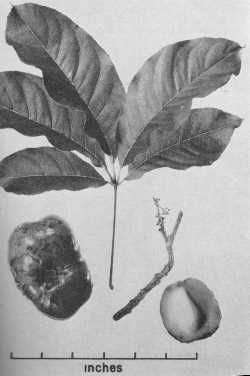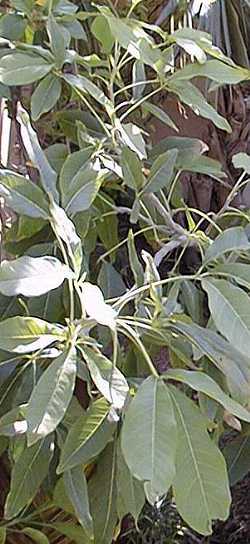Sunset®: 15-16,22-24
USDA: 9b-10
Frost Tolerance: Hardy in Phoenix, foliage damaged at 28° F (-2° C), serious damage at 22° F (-5° C)
Heat Tolerance: Good resistance in Phoenix
Sun Exposure: Full sun
Origin: Mexican highlands
Growth Habits: Mostly evergreen tree to 50 feet (15 m)
Watering Needs: Regular water
Propagation: Seeds, budding, grafting

This Mexican fruit forms a medium-sized to large erect or spreading evergreen tree. The palmately compound dark green leaves commonly have 5 leaflets of varying size, the largest 6 to 8 inches in length by about 3 inches in width (15 to 20 cm by 7 cm).
A number of White Sapote varieties have been selected.
A closely related species, the Woollyleaf White Sapote (Casimiroa tetrameria Millsp.), is sometimes grown for its fruit. It can be distinguished from the white sapote by its larger leaves with dense white fuzz on the underside, and by its slightly larger fruits.
Blooming Habits:
The small inconspicuous, greenish-yellow flowers are borne on both terminal and axillary panicles.
Fruiting Habits:
The tree produces an abundance of ovoid fruits that are up to 4 inches in diameter and have a thin green skin which turs greenish yellow at maturity. The creamy or yellowish flesh is melting and juicy and had a distinctive sweet flavor. Each fruit has 1 to 5 large ovoid or ellipsoid seeds imbedded in the flesh. The fruit is picked when fully mature but while still firm; the fruit softens to edible condition in 2 to 3 days. Overripe fruit becomes slightly bitter. While the fruit can be eaten out of hand, many people prefer it as a dessert fruit with cream and sugar.
Culture:
Sapote does much better with regular fertilizing, use a citrus fertilizing program.
Propagation:
The fruit contains a varying percentage of sterile seeds that are markedly smaller than fertile seeds. Fertile seeds will usually germinate in a month. Seedlings take 7 or 8 years to come into bearing, and their fruit is generally of inferior quality. Spring is the best time for grafting.
Links:
CRFG Fruit Facts
Desert-Tropicals is dedicated to provide gardening advice, gardening ideas, and information about flower of all kind for landscape and collections.We try to check carefully the identification of the plants on the illustrations as well as the other information from the page, but occasionally errors do occur. if you notice anything that needs to be changed please contact us.Thanks.
© 1998-2020 Philippe Faucon, All Rights Reserved.
